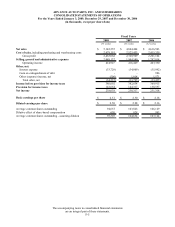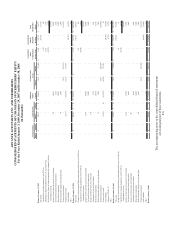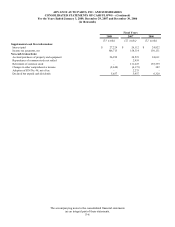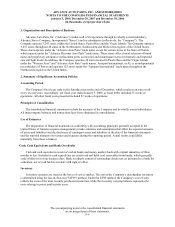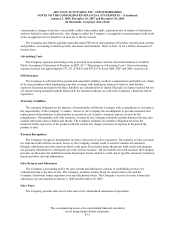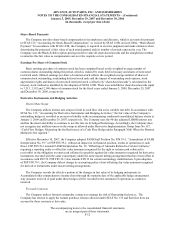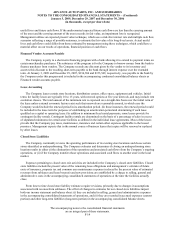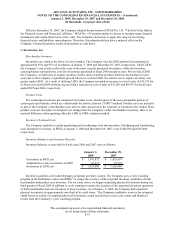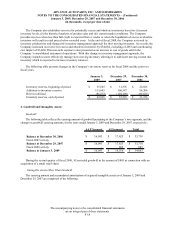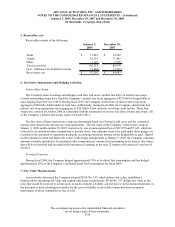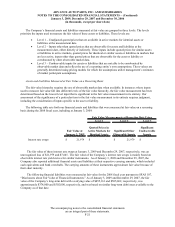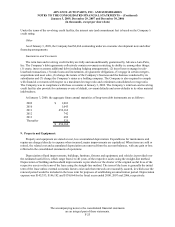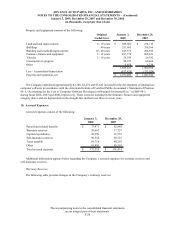Advance Auto Parts 2008 Annual Report Download - page 69
Download and view the complete annual report
Please find page 69 of the 2008 Advance Auto Parts annual report below. You can navigate through the pages in the report by either clicking on the pages listed below, or by using the keyword search tool below to find specific information within the annual report.
ADVANCE AUTO PARTS, INC. AND SUBSIDIARIES
NOTES TO THE CONSOLIDATED FINANCIAL STATEMENTS – (Continued)
January 3, 2009, December 29, 2007 and December 30, 2006
(in thousands, except per share data)
The accompanying notes to the consolidated financial statements
are an integral part of these statements.
F-15
Cost of Sales and Selling, General and Administrative Expenses
The following table illustrates the primary costs classified in each major expense category:
●Total cost of merchandise sold including: ●Payroll and benefit costs for retail and corporate
–Freight expenses associated with moving team members;
merchandise inventories from our vendors to ●Occupancy costs of retail and corporate facilities;
our distribution center, ●Depreciation related to retail and corporate assets;
–Vendor incentives, and ●Advertising;
–Cash discounts on payments to vendors; ●Costs associated with our commercial delivery
●Inventory shrinkage; program, including payroll and benefit costs,
●Defective merchandise and warranty costs; and transportation expenses associated with moving
●Costs associated with operating our distribution merchandise inventories from our retail stores to
network, including payroll and benefit costs, our customer locations;
occupancy costs and depreciation; and ●Freight expenses associated with moving
●Freight expenses associated with moving merchandise inventories from other centralized
merchandise inventories from our distribution stores and Parts Delivered Quickly warehouses,
center to our retail stores. or PDQs
®
, to our retail stores after the customer
has special-ordered the merchandise;
●Self-insurance costs;
●Professional services; and
●Other administrative costs, such as credit card
service fees, supplies, travel and lodging.
Cost of Sales SG&A
New Accounting Pronouncements
In June 2008, the Financial Accounting Standards Board, or FASB, issued FASB Staff Position, or FSP, EITF
03-6-1, “Determining Whether Instruments Granted in Share-Based Payment Transactions Are Participating
Securities.” FSP EITF 03-6-1 addresses whether instruments granted in share-based payment transactions are
participating securities prior to vesting, and therefore need to be included in the earnings allocation in computing
earnings per share under the two-class method as described in Statement of Financial Accounting Standards, or
SFAS, No. 128, “Earnings per Share.” Under the guidance of FSP EITF 03-6-1, nonvested share-based payment
awards that contain nonforfeitable rights to dividends or dividend equivalents (whether paid or unpaid) are
participating securities and shall be included in the computation of earnings-per-share pursuant to the two-class
method. FSP EITF 03-6-1 is effective for financial statements issued for fiscal years beginning after
December 15, 2008 and all prior-period earnings per share data presented shall be adjusted retrospectively. Early
application is not permitted. The Company does not anticipate the adoption of FSP EITF 03-6-1 will have an impact
on its earnings per share.
In June 2008, the FASB Issued EITF No. 08-3, “Accounting by Lessees for Nonrefundable Maintenance
Deposits.” EITF 08-3 requires that nonrefundable maintenance deposits paid by a lessee under an arrangement
accounted for as a lease be accounted for as a deposit asset until the underlying maintenance is performed. When the
underlying maintenance is performed, the deposit may be expensed or capitalized in accordance with the lessee’s
maintenance accounting policy. Upon adoption entities must recognize the effect of the change as a change in
accounting principle. EITF 08-3 is effective for financial statements issued for fiscal years beginning after
December 15, 2008. The Company does not expect the adoption of EITF 08-3 will have a material impact on its
financial condition, results of operations or cash flows.
In April 2008, the FASB issued FASB Staff Position No. FAS 142-3, “Determination of the Useful Life
of Intangible Assets”, which amends the factors that must be considered in developing renewal or extension
assumptions used to determine the useful life over which to amortize the cost of a recognized intangible asset under
SFAS 142, “Goodwill and Other Intangible Assets.” The FSP requires an entity to consider its own assumptions
about renewal or extension of the term of the arrangement, consistent with its expected use of the asset, and is an


